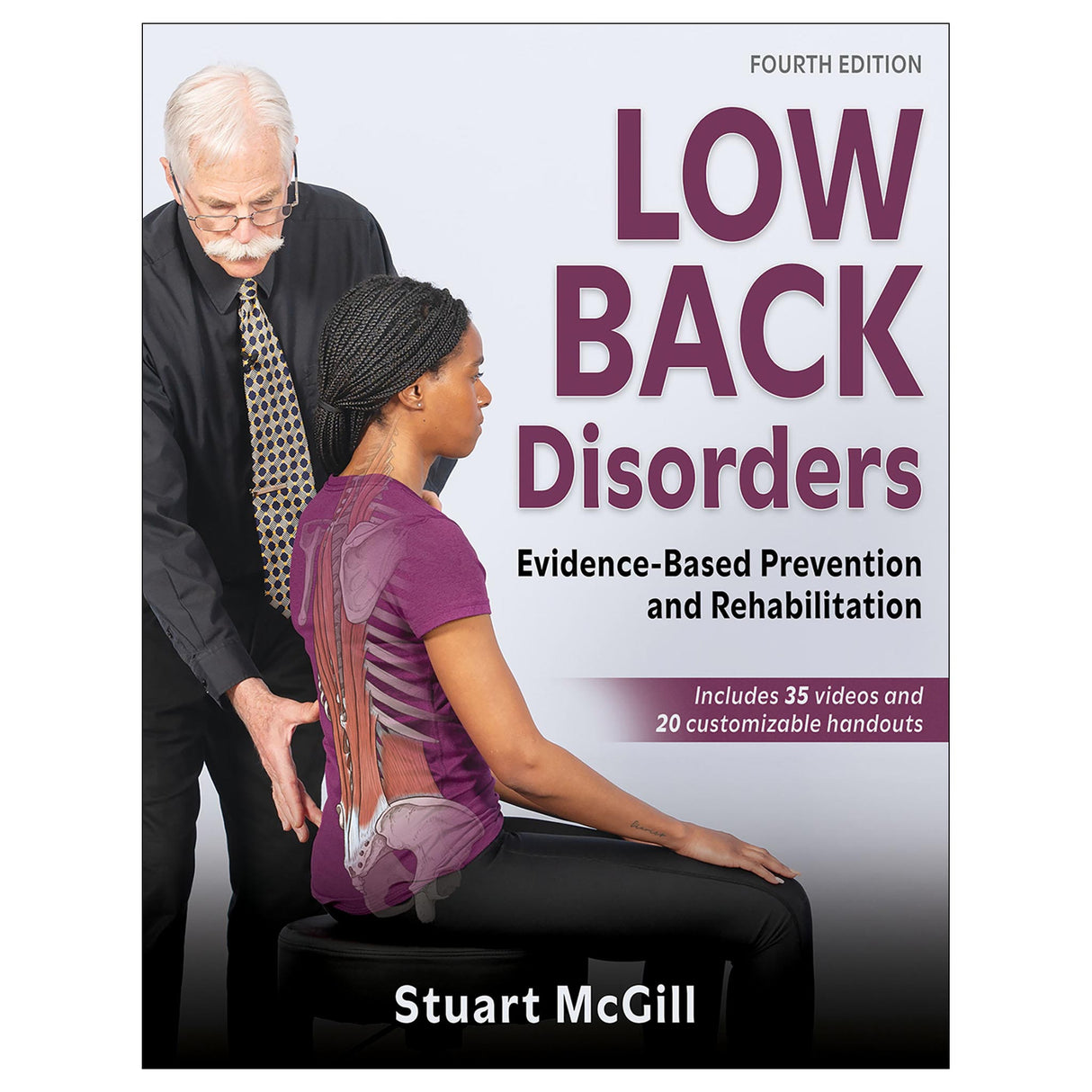Low Back Disorders 4th Edition With HKPropel Access
Evidence-Based Prevention and Rehabilitation
Author: Stuart McGill
$138.95 CAD
In Low Back Disorders, Fourth Edition With HKPropel Access, internationally recognized low back specialist Stuart McGill, PhD, presents the research and applications of back anatomy, injury mechanisms, and biomechanics to build effective prevention and rehabilitation programs for patients or clients. Common misconceptions about pain and discomfort are addressed and corrected. Detailed insights into injury assessment are provided through a series of cutting-edge tests, with accompanying instructions, along with guidance and recommendations for individualized rehabilitation strategies and exercises.
The fourth edition of Low Back Disorders now presents photos, illustrations, and graphs in full color to encourage a deep understanding of complex topics. The text includes access to 35 related video clips (17 of which are new to this edition) that illustrate key concepts from the text and guide readers in how to properly cue exercises and movements. With 80 exercises and tests, patient assessment has been extensively enhanced with more information about provocative testing. The fourth edition has been updated with the latest evidence-based information and includes new sections on the following topics:
- The important role of fascia for efficient movement with minimal stress concentrations on vulnerable anatomical parts
- The benefits of choosing less stressful ways to move and reducing loading in the early stage of rehabilitation
- A bolstered assessment section with more tests to converge on a precise and specific understanding of the pain pathway
- The correct way to graduate from recovery to performance exercise
Throughout the text, the author offers examples from everyday movements and activities to connect the mechanisms for low back pain to the clients and patients who present with these challenges. Learning aids such as checklists, sidebars, and a glossary help readers absorb and retain information. In addition to the video clips, 21 patient handouts that can be customized and printed out are available online via HKPropel Access.
Low Back Disorders, Fourth Edition, begins by introducing the functional anatomy and biomechanics of the lumbar spine. It presents epidemiological studies on low back disorders and dispels common myths of lumbar spine stability. Part II reviews risk factors for low back disorders and common prevention methods, with specific attention paid to reducing workplace risk factors. Part III explains evaluating and diagnosing clients and developing exercise and rehabilitation programs. Specific exercises that are proven to enhance performance and reduce pain are also explained.
Evidence-based research and cutting-edge application strategies from a leading spine specialist make Low Back Disorders, Fourth Edition, the authoritative text for the examination and rehabilitation of the low back. Its approach to back care will lead readers in developing intervention, rehabilitation, and prevention programs to address the unique needs of each patient or client.
Earn continuing education credits/units! A continuing education exam that uses this book is also available. It may be purchased separately or as part of a package that includes both the book and exam.
Note: A code for accessing HKPropel is included with all new print books.
Audience
A reference for physical and occupational therapists, sport and orthopedic physicians, rehabilitation specialists, athletic trainers, and fitness specialists. Also useful for students as a primary or secondary resource on biomechanics and low back disorders.Part I. Scientific Foundation
Chapter 1. Introduction to the Issues and Scientific Approach Unique to This Book
Legislative Landscape: The Unfortunate Adverse Impact on Painful Backs
Nonspecific Low Back Pain: The Diagnosis That Impedes Understanding the Pain Pathway
Deficiencies in Current Diagnostic Practices
Alternatives to Addressing Mechanical Pain: Pain Science?
Misinterpretation of Biomechanics Studies Due to Differences in Internal Versus External Mechanics
Does Posture Matter, or Is There No Such Thing as Bad Posture?
Inadequacies in Current Care and Prevention
Mechanostimulation: The Determinant of Either Optimal Health or Injury
Excellent Clinicians and Excellent Practice
Unique Scientific Foundation of This Book
In Vitro Lab
In Vivo Lab
A Final Note
Chapter 2. Epidemiological Studies and What They Really Mean
Consuming Science
Influence of Randomized Controlled Trials and Other Epidemiological Approaches
Misunderstandings of Epidemiology
Multidimensional Links Between Biomechanical, Psychosocial, and Personal Variables
How Do Biomechanical Factors Affect LBDs?
Links Between Personal Factors and LBDs
Studies of Exercise Intervention
Practical Application: What the Evidence Supports
What Works Clinically
A Final Note
Chapter 3. Functional Anatomy of the Lumbar Spine
Anatomy Trains
Fascia: How Our Understanding Has Changed and Its Large Influence on Biomechanics, Resilience, and Performance
Basic Neural Structure
Vascular Anatomy
Vertebrae
Sacroiliac Joints
Intervertebral Discs
Muscles
Ligaments
Lumbodorsal Fascia
Quick Review of the Pelvis, Hips, and Related Musculature
Clinically Relevant Aspects of Pain and Anatomic Structure
A Final Note
Chapter 4. Normal and Injury Mechanics of the Lumbar Spine
Kinematic Properties of the Thoracolumbar Spine
Kinetics and Normal Lumbar Spine Mechanics
Dubious Lifting Mechanisms
Other Important Mechanisms of Normal Spine Mechanics
Injury Mechanisms
Biomechanical and Physiological Changes Following Injury
A Final Note
Chapter 5. Myths and Realities of Lumbar Spine Stability
Stiffness and Stability
Why Spine Stability Is Important for Everyone
Stability: A Qualitative Analogy
Quantitative Foundation of Stability
Stability Myths, Facts, and Clinical Implications
A Final Note
Part II. Injury Prevention
Chapter 6. Low Back Disorder Risk Assessment
Brief Review of the Risk Factors for LBDs
NIOSH Approach to Risk Assessment
Snook Psychophysical Approach
Lumbar Motion Monitor
Ergowatch Approach
Biological Signal–Driven Model Approaches
A Final Note
Chapter 7. Reducing the Risk of Low Back Injury
Lessons From the Literature
LBD Prevention for Workers
The Question of Back Belts
LBD Prevention for Employers
Injury Prevention Primer
A Note for Consultants
Reducing the Risk in Athletes
Some Thoughts for Daily Living
A Final Note
Part III. Low Back Rehabilitation
Chapter 8. Building Better Rehabilitation Programs for Low Back Injuries
Pain-Reducing Mechanisms of Exercise
Five-Stage Back Training Program
Finding the Best Approach
Stages of Patient Progression
Guidelines for Developing the Best Exercise Regimen
A Final Note
Chapter 9. Evaluating the Patient
Mastery in Assessment and Converging on a Specific Diagnosis
The Most Crucial Element in Evaluation
First Clinician–Patient Meeting
Assessing Posture and Movement Quality
Provocation Tests
Functional Screens
Testing Muscle Endurance
Designing the Assessment: Choosing Assessment Tests and Their Order
A Final Note
Chapter 10. Developing the Exercise Program
Philosophy of Low Back Exercise Design
Clinical Wisdom
Thoughts on Mobility
Identifying Safe and Effective Exercises
Beginner Program for Pain Control and Stabilization
Exercises That May Be Used in a Stabilization Program
Special Conditions
Thoughts for Seniors: The Biblical Training Week
A Final Note
Chapter 11. Advanced Exercises: Preparing for a More Robust Life
Safely Increasing Challenges
Occupational and Athletic Work Hardening
A Final Note
Epilogue
Appendix
Glossary
References and Additional Readings
Index
Femoral root flossing
Nontraditional perspectives on the spine
 Stages of model output
Stages of model output Short muscles of the posterior spine
Short muscles of the posterior spine Spine stiffening structures
Spine stiffening structures Targeting gluteus medius and maximus
Targeting gluteus medius and maximus
All ancillaries are free to adopting instructors through HKPropel.
Image bank. Includes most of the figures, content photos, and tables from the text, sorted by chapter. These can be used in developing a customized presentation based on specific course requirements.






